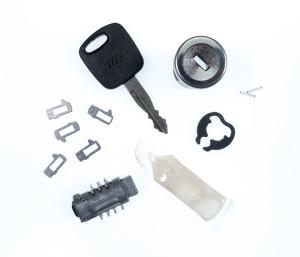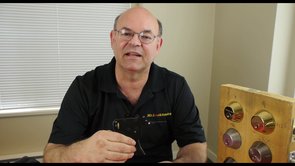How to rekey a Strattec Ford Focus Ignition 707592 Kit | Mr. Locksmith Blog
For further information go to Mr. Locksmith Training
Ford Focus ignitions are a huge money maker for locksmiths. Those sidebar ignitions have been failing like crazy. When they first started failing we would get the replacement parts or new ignitions from Ford. The Ford igntion had the sidebar and it would fail again and we were stuck under warranty fixing the problem. The Strattec kit Ford Focus Kit 707592 is fantastic. It’s everything you need inside the kit. It doesn’t have the sidebar so the lock is not going to fail because of a sidebar malfunction. In the following, Randy from Mr. Locksmith Automotive is going to explain, step-by-step instructions on how to re-key the Strattec ignition replacement lock so it fits perfectly with the client’s key. The client can still use one key that will fit the whole car, work the doors, work the ignition and start the car.

Mr. Locksmith Ford Ignition 707592

Mr. Locksmith Ford Ignition 707592
The number one failing lock on the market today is the Ford Focus. It runs from about the year 2000 to the year 2004. I have had later Ford Ignitions fail too. This particular lock is a good example of what fails on the Ford Focus. The sidebar is what fails. This is an example of a Ford Focus igntiion lock that we removed last week and if you put the key in you’ll notice, in here, that the cylinder drops a bit but it doesn’t drop … Or the sidebar drops a bit but it doesn’t drop nearly enough to turn in the cylinder. So you can put it in. You can try and turn it all you want. It’s not going to move. The replacement kit we use this Strattec kit Ford Igniton part number 707592. It eliminates the sidebar and eliminates all problems to do with this, this failure here on the sidebar. This kit is very easy to re-key and you can have a working lock in about ten minutes.
Strattec builds a nice replacement lock, they put everything you’ll need to do the job done. The cylinder plug goes into the cylinder. The kit has all the depths of the wafers – one to five and all the springs. The nice thing about Strattec is they do give you extra springs because inevitably you’re going to drop one or two of them during the process.
We are going to rekey the new igntion to the customers existing ignition key. You can pretty much eyeball the key and tell the depths on the key. The cylinder itself, with Fords of these year you are looking at six wafers in the doors and you’re looking at seven wafers in the ignition. The key is an 8-cut, looking from bow to tip you have eight cuts in it. The ignition lock cylinder for this vehicle runs from two to eight.
Where we’ll start is we’ll take the springs out. Now on the table there. The springs always end up in little bundles but you can easily separate them. Now uh, I know the first cut in here is a two. The next one if a four so you’re going to put a spring in the first position. You’re going to open up your kit with number four, take out our wafer. You’re going to plug it in here. And it’ll snap into place by pushing it down. And you put the key in. You can notice that it clears … So that you have nothing above the shear line. Pull it out and this is what’s going to stop it from turning. Now if you take another key that doesn’t have a four in the next position and this … You can see how it sticks up and the cylinder won’t turn. And the cylinder will turn.
So your first wafer is in. You look at the key. You’ve got a four there. Your next cut, by reading it is a two so just take another spring, pop it into the other side and get your next wafer on number two and pop your number two wafer in there. I tend to check as I’m going just to make sure that we’re clearing all the way along.
Based on the key we know the next cut is a four. Just so you can see the difference I’m going to stick a one in there and you can see just what happens when the wafers are out. So we stick a number one in there, stick the key in, and you can see how far out that number one sticks. So that will never turn in the cylinder. So let’s take that out and let’s get back to the four we need.
And we clear. Go onto the next one. Pop the spring in. Now looking at the key again we’re at another number two. If you look at the two, four, two, four, four, two, if you look at the key very closely you can see that these twos have the same height so you’ll learn to read the keys in a heck of a hurry.
Next spring, again looking at the key, we know that’s a number two right there. Next cut in is a little deeper. It’s a number three. [inaudible 00:07:31] number three. Pin that. Check it again. We know we’ve cleared. And we’re going to go on to our last wafer here. And if you look at the key we’re going figure that’s a number five because it’s the deepest cut. When you go along here you can see just how deep that cut is. We plug in the number five and we’ve cleared our shear line on all of the … On all of the wafers.
You can do a partial test if you just take your key and your lock and you just kind of slip it in backwards, you can just see how nice and easy it turns in there. It won’t go in all the way. You won’t get the last wafer in, but it’s just a good test to see how it works. So as you can see, although it is an eight-cut key, there are only seven wafers. One, two, three, four, five six, seven in the ignition. So there’s cuts two to seven for the ignition.
Now to put the lock together, basically, you’re lining up this guide with this slot here. We’re going to put it in and you’re going to feed the wafers one at a time. And you’ll hit a point where it won’t go any further until you turn it because there’s a slot in the lock that you need to line up before it will go any further. And then the lock will go together like that. Now once you turn this, it’ll lock in place and that lock cylinder is not going to come back out.
Last part of the process is to put the snap ring on to the end of the cylinder and then install it in the vehicle.
In conclusion, Randy just gave a great step-by-step instructions on how to re-key the Strattec ignition so the customers key will still work the ignition. This stops you from having to program a new transponder key. The customer can still have one key fit the door, fit the ignition and start the car. It’s a pretty simple remove and replace. Put in this new Strattec ignition. It’s a fantastic product.
Ford Focus ignitions are a huge money maker for locksmiths. Those sidebar ignitions have been failing like crazy. When they first started failing we would get the replacement parts or new ignitions from Ford. The Ford igntion had the sidebar and it would fail again and we were stuck under warranty fixing the problem. The Strattec kit Ford Focus Kit 707592 is fantastic. It’s everything you need inside the kit. It doesn’t have the sidebar so the lock is not going to fail because of a sidebar malfunction. In the following, Randy from Mr. Locksmith Automotive is going to explain, step-by-step instructions on how to re-key the Strattec ignition replacement lock so it fits perfectly with the client’s key. The client can still use one key that will fit the whole car, work the doors, work the ignition and start the car.
The number one failing lock on the market today is the Ford Focus. It runs from about the year 2000 to the year 2004. I have had later Ford Ignitions fail too. This particular lock is a good example of what fails on the Ford Focus. The sidebar is what fails. This is an example of a Ford Focus igntiion lock that we removed last week and if you put the key in you’ll notice, in here, that the cylinder drops a bit but it doesn’t drop … Or the sidebar drops a bit but it doesn’t drop nearly enough to turn in the cylinder. So you can put it in. You can try and turn it all you want. It’s not going to move. The replacement kit we use this Strattec kit Ford Igniton part number 707592. It eliminates the sidebar and eliminates all problems to do with this, this failure here on the sidebar. This kit is very easy to re-key and you can have a working lock in about ten minutes.
Strattec builds a nice replacement lock, they put everything you’ll need to do the job done. The cylinder plug goes into the cylinder. The kit has all the depths of the wafers – one to five and all the springs. The nice thing about Strattec is they do give you extra springs because inevitably you’re going to drop one or two of them during the process.
We are going to rekey the new igntion to the customers existing ignition key. You can pretty much eyeball the key and tell the depths on the key. The cylinder itself, with Fords of these year you are looking at six wafers in the doors and you’re looking at seven wafers in the ignition. The key is an 8-cut, looking from bow to tip you have eight cuts in it. The ignition lock cylinder for this vehicle runs from two to eight.
Where we’ll start is we’ll take the springs out. Now on the table there. The springs always end up in little bundles but you can easily separate them. Now uh, I know the first cut in here is a two. The next one if a four so you’re going to put a spring in the first position. You’re going to open up your kit with number four, take out our wafer. You’re going to plug it in here. And it’ll snap into place by pushing it down. And you put the key in. You can notice that it clears … So that you have nothing above the shear line. Pull it out and this is what’s going to stop it from turning. Now if you take another key that doesn’t have a four in the next position and this … You can see how it sticks up and the cylinder won’t turn. And the cylinder will turn.
So your first wafer is in. You look at the key. You’ve got a four there. Your next cut, by reading it is a two so just take another spring, pop it into the other side and get your next wafer on number two and pop your number two wafer in there. I tend to check as I’m going just to make sure that we’re clearing all the way along.
Based on the key we know the next cut is a four. Just so you can see the difference I’m going to stick a one in there and you can see just what happens when the wafers are out. So we stick a number one in there, stick the key in, and you can see how far out that number one sticks. So that will never turn in the cylinder. So let’s take that out and let’s get back to the four we need.
And we clear. Go onto the next one. Pop the spring in. Now looking at the key again we’re at another number two. If you look at the two, four, two, four, four, two, if you look at the key very closely you can see that these twos have the same height so you’ll learn to read the keys in a heck of a hurry.
Next spring, again looking at the key, we know that’s a number two right there. Next cut in is a little deeper. It’s a number three. [inaudible 00:07:31] number three. Pin that. Check it again. We know we’ve cleared. And we’re going to go on to our last wafer here. And if you look at the key we’re going figure that’s a number five because it’s the deepest cut. When you go along here you can see just how deep that cut is. We plug in the number five and we’ve cleared our shear line on all of the … On all of the wafers.
You can do a partial test if you just take your key and your lock and you just kind of slip it in backwards, you can just see how nice and easy it turns in there. It won’t go in all the way. You won’t get the last wafer in, but it’s just a good test to see how it works. So as you can see, although it is an eight-cut key, there are only seven wafers. One, two, three, four, five six, seven in the ignition. So there’s cuts two to seven for the ignition.
Now to put the lock together, basically, you’re lining up this guide with this slot here. We’re going to put it in and you’re going to feed the wafers one at a time. And you’ll hit a point where it won’t go any further until you turn it because there’s a slot in the lock that you need to line up before it will go any further. And then the lock will go together like that. Now once you turn this, it’ll lock in place and that lock cylinder is not going to come back out.
Last part of the process is to put the snap ring on to the end of the cylinder and then install it in the vehicle.
In conclusion, Randy just gave a great step-by-step instructions on how to re-key the Strattec ignition so the customers key will still work the ignition. This stops you from having to program a new transponder key. The customer can still have one key fit the door, fit the ignition and start the car. It’s a pretty simple remove and replace. Put in this new Strattec ignition. It’s a fantastic product.
For On-line and Hands-on Locksmith Training Dates and Cities near you for Beginners, Intermediate, Advanced Locksmithing as well as my Covert Methods of Entry, Non-destructive Methods of Entry and to purchase the Famous “Dumb Key Force Tool” that opens Smart Key locks in seconds go to Mr. Locksmith Training https://mrlocksmithtraining.com/
For Locksmith Franchise and Licensing Opportunities go to Mr. Locksmith webpage

